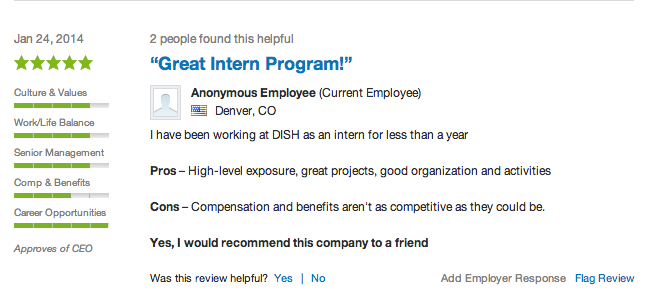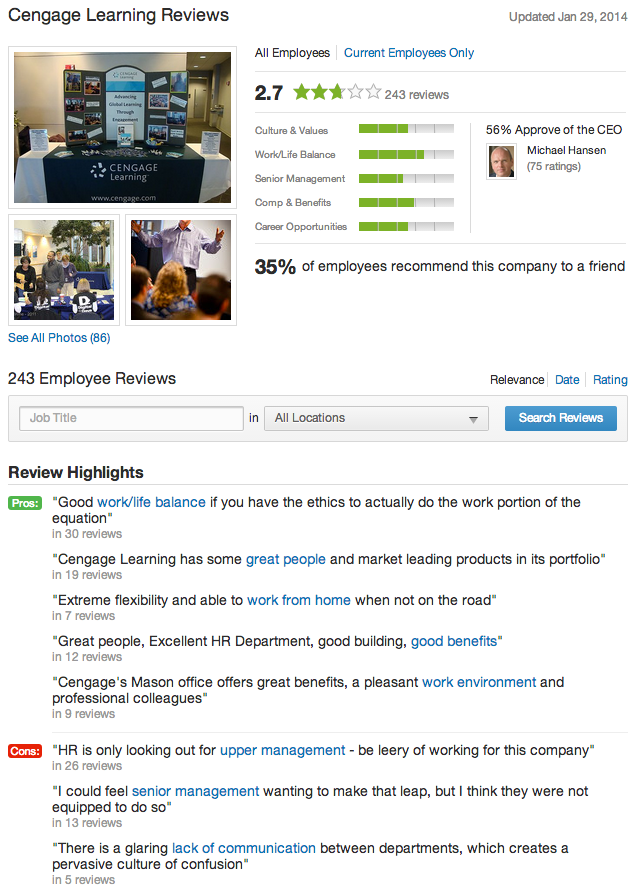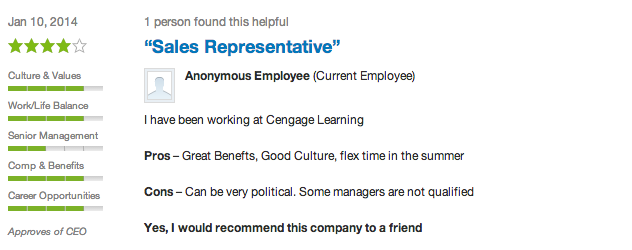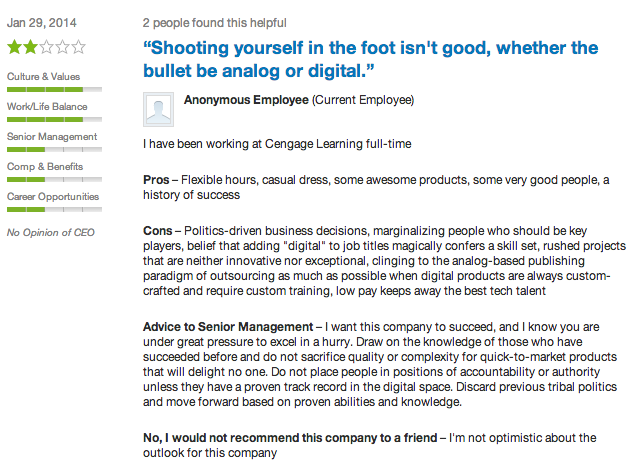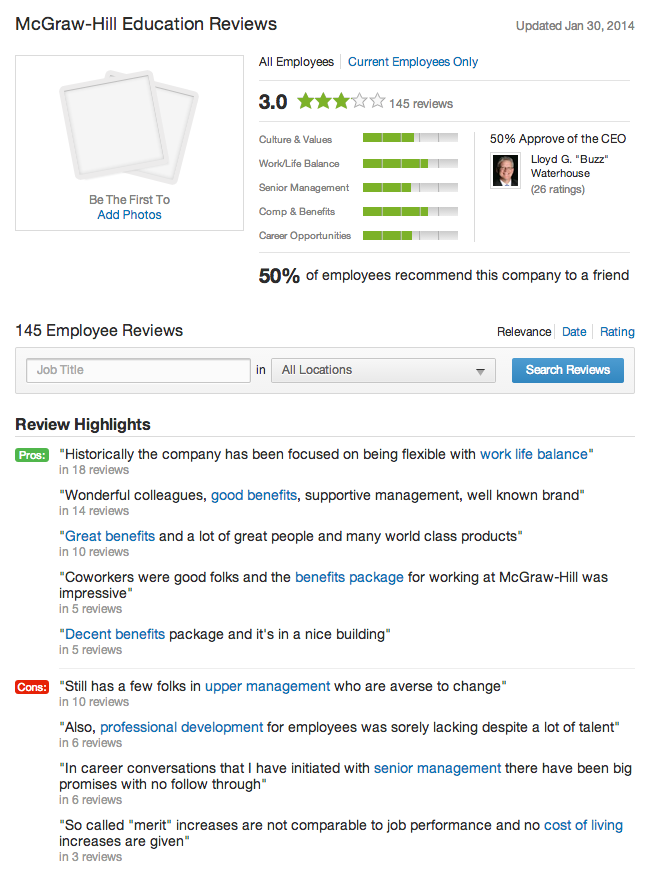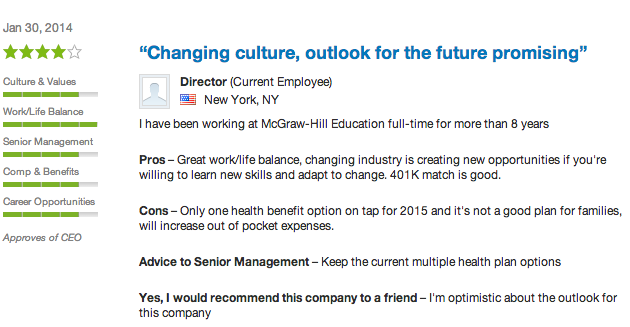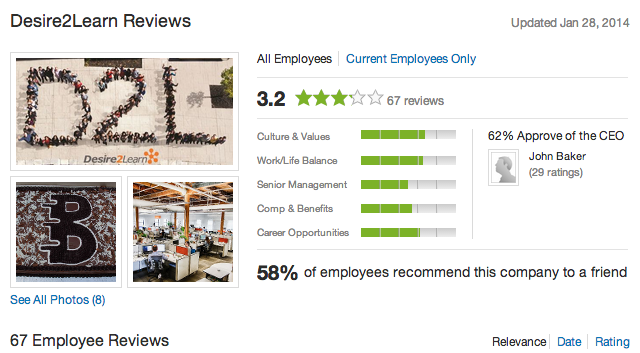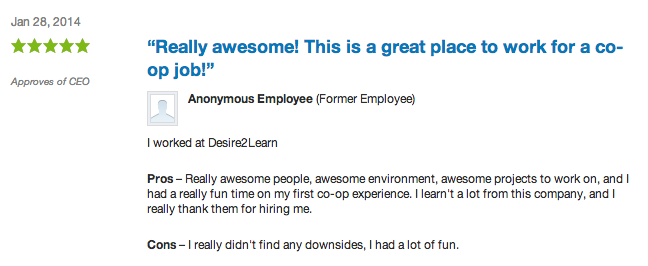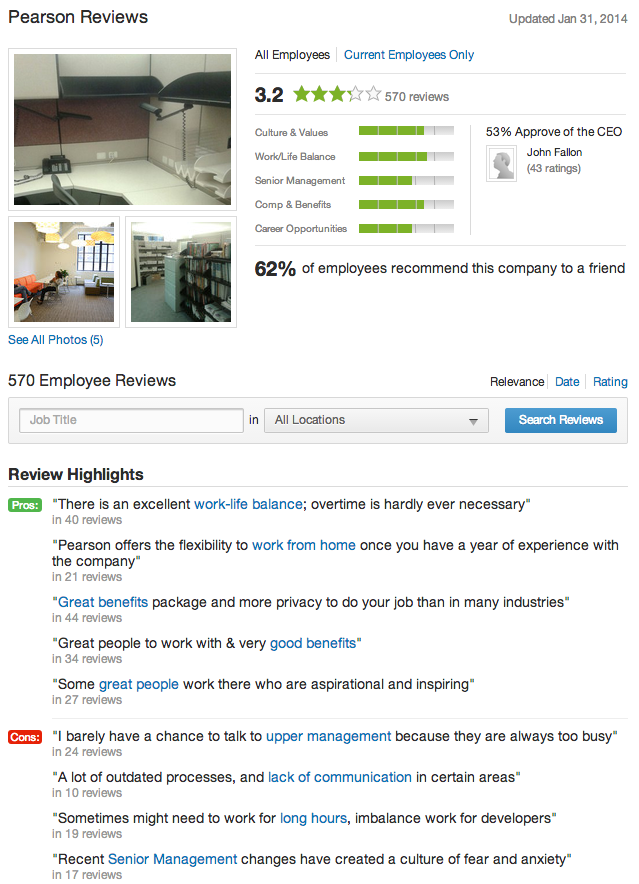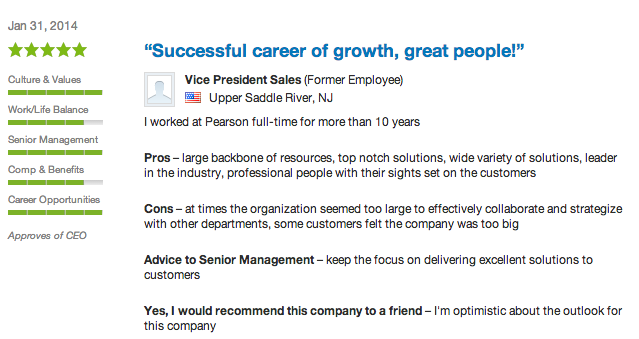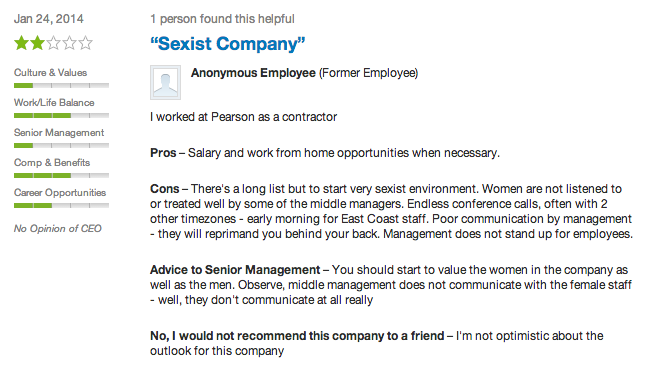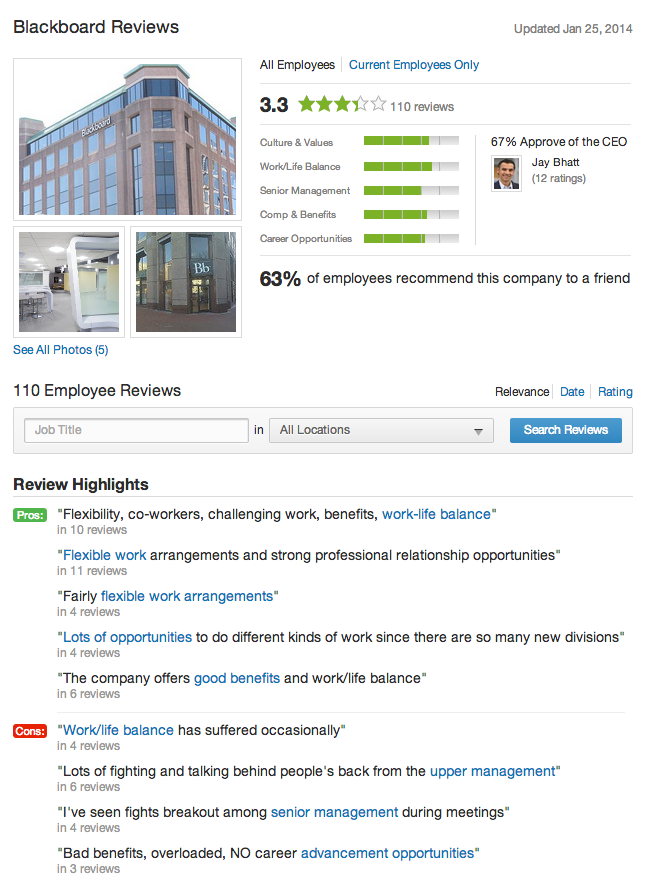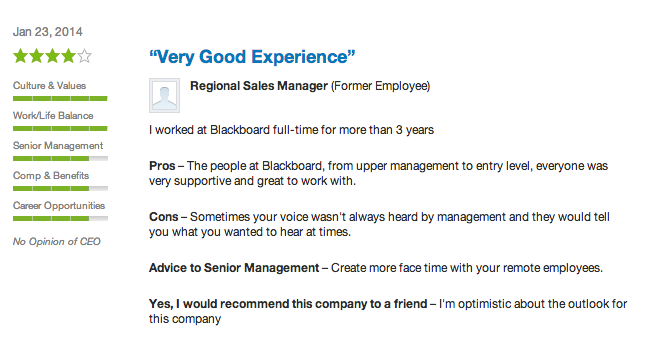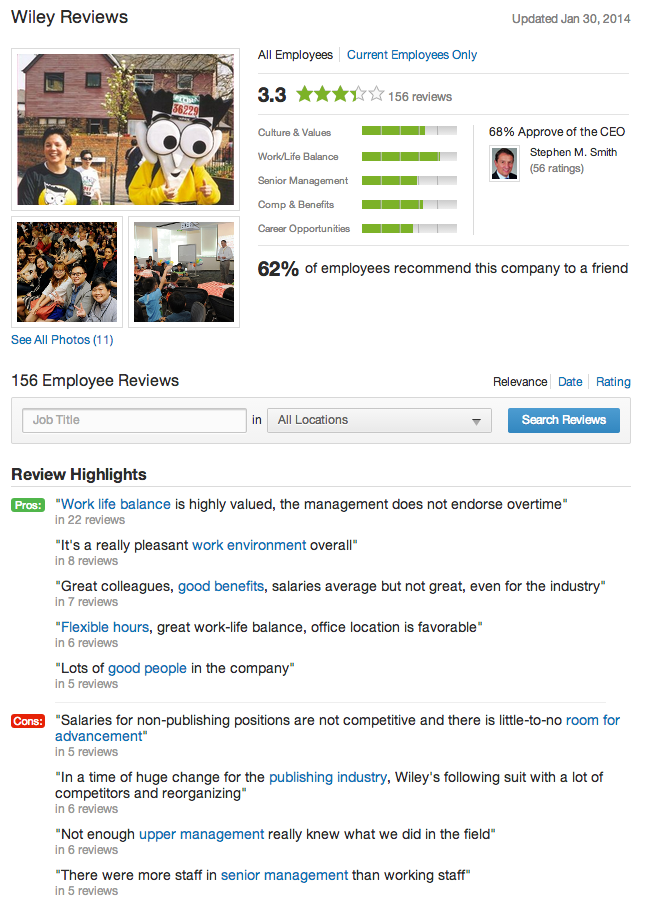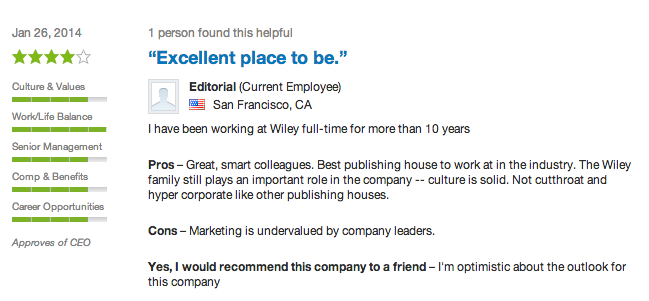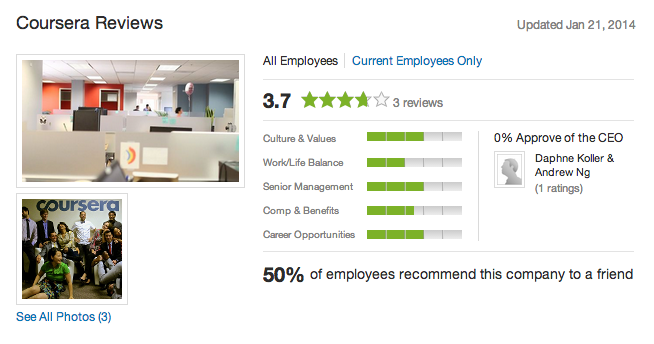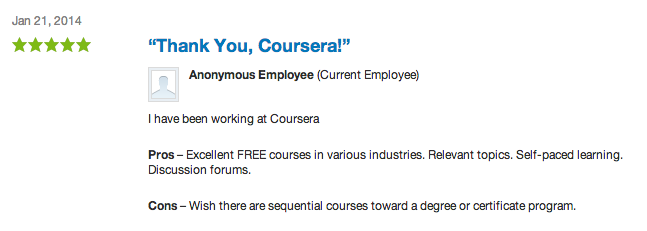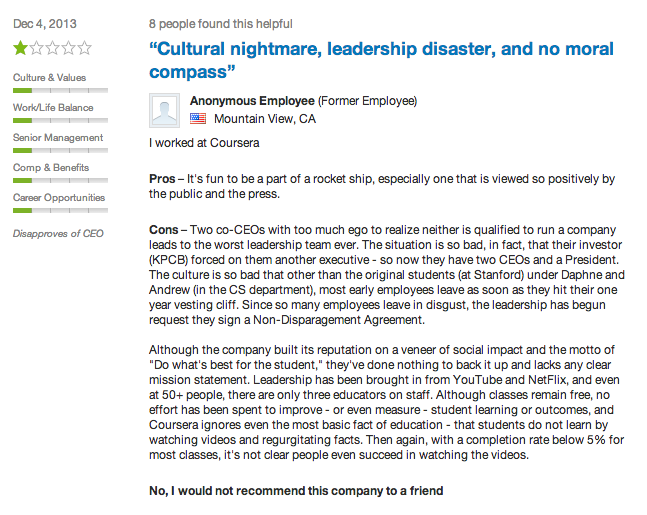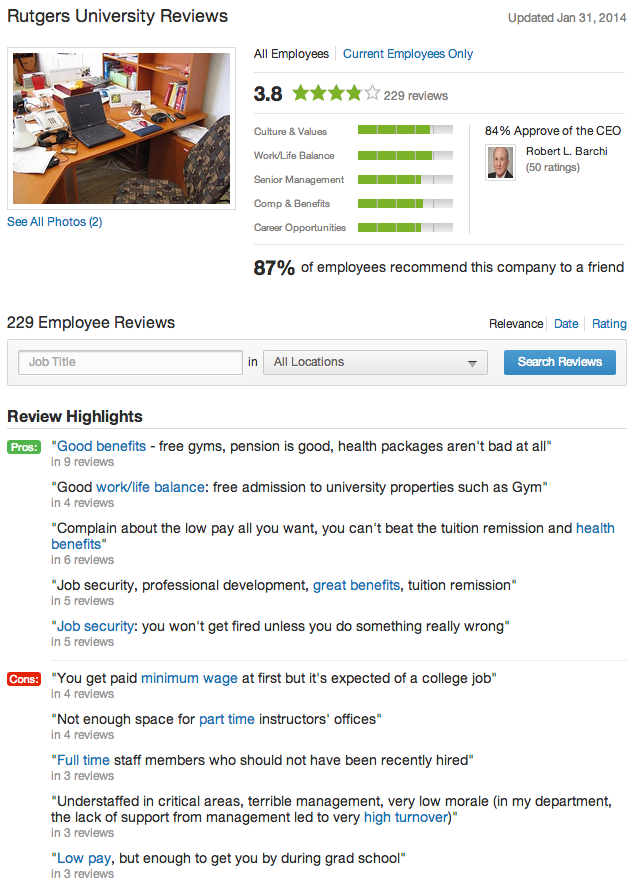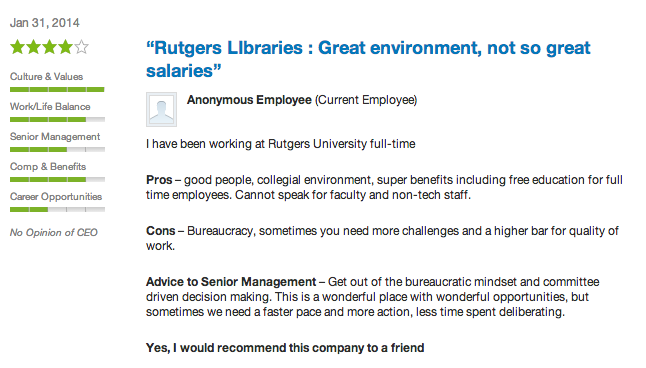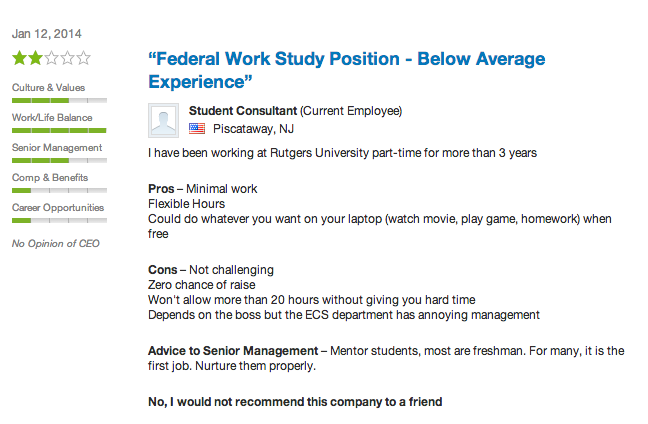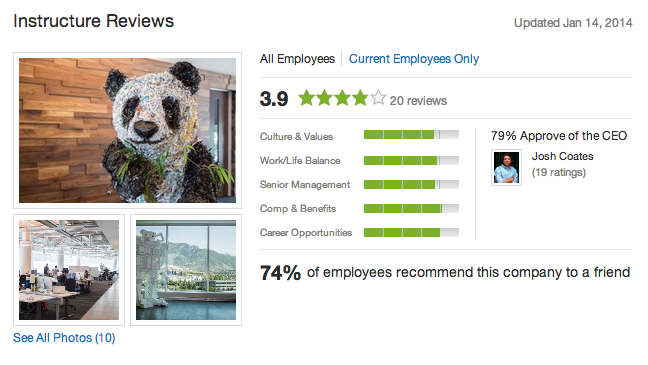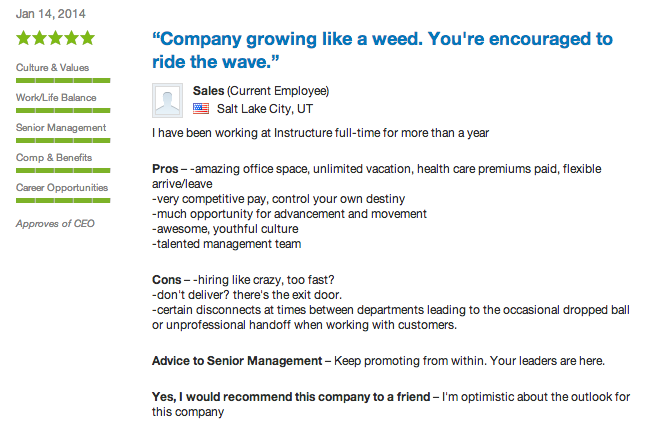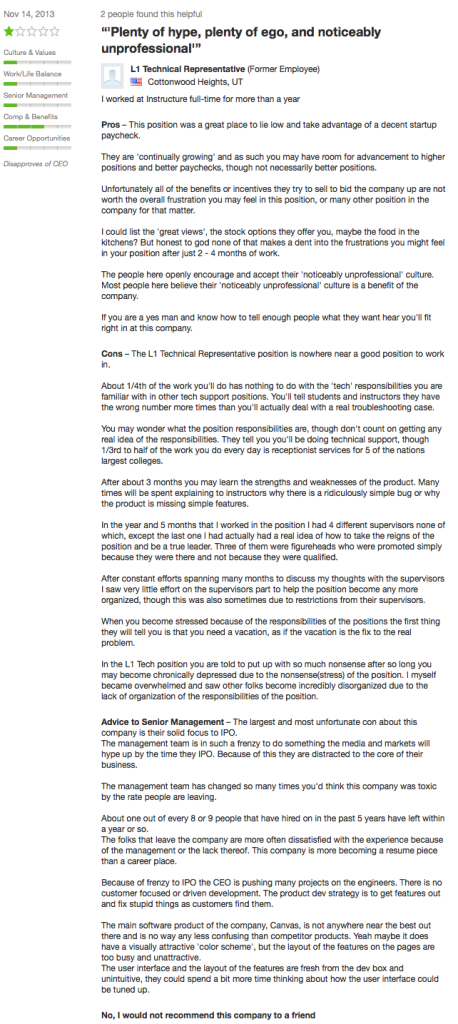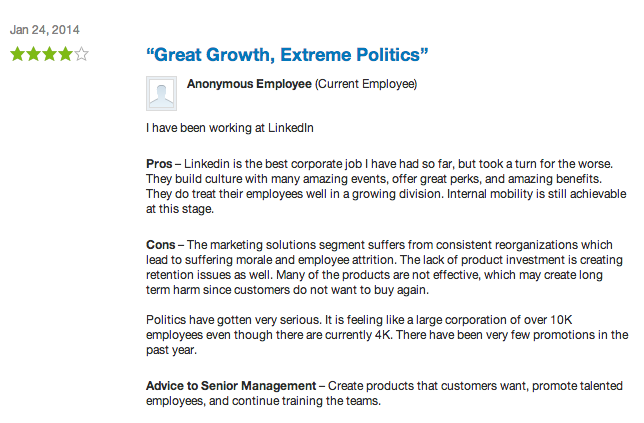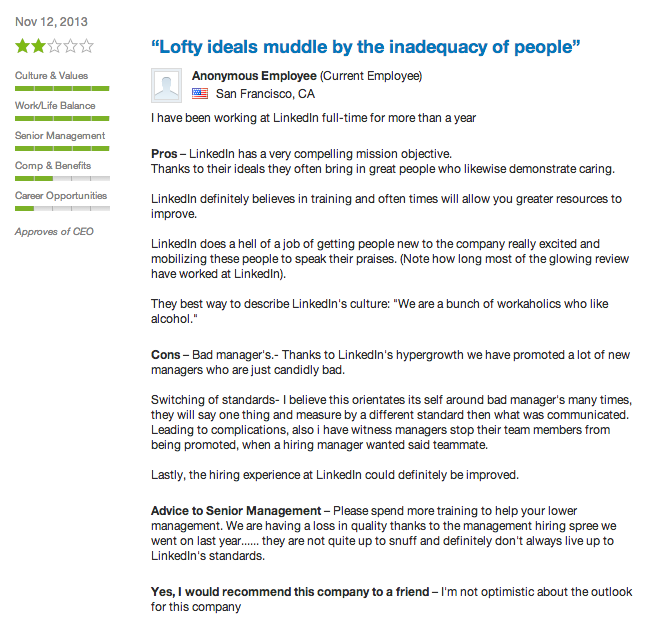Update: For reference, 2U has pointed out to me that they were recently recognized by Glassdoor as the 17th-best medium-sized company to work for in 2014. With an average score of 4.2 (based on 21 reviews), this puts them on top of the other ed tech companies discussed here. The only other education company on the Glassdoor best places lists is Edmentum which, oddly, only has a 3.1 average rating based on 37 reviews.
Second Update: All the education companies that have scored well on Glassdoor are coming out of the woodwork now. W.W. Norton has pointed out to me that the have a 4.2 average rating, based on 47 reviews. That puts them tied for first among education companies (that I know of) with 2U.
One way to get a sense of how the companies whose products you depend on are doing is to talk to their employees. This is particularly helpful at times like this, when huge changes are underway. So I thought it would be interesting to take a survey of the employee reviews on Glassdoor of some of the major companies in the industry. The results are revealing, if not entirely surprising.
Methodology
I looked at the three biggest US LMS players (Blackboard, Desire2Learn, and Instructure) and four of the biggest textbook providers (Pearson, McGraw Hill, Cengage, and Wiley). I added the best- and worst-ranked companies on Glassdoor to provide reference points. I threw in Rutgers University (my alma mater) and Coursera just for fun. I have ordered the presentation from lowest ranking to highest. For easy scanning, I put the average rank number in red if it was below the middle 3 out of 5 score, orange if it was on the line, and green if it was above the line. In addition to showing any summary review and ranking information Glassdoor provides on each company, I picked the most recent review with four stars or higher and the most recent review with two stars or lower to give examples of positive or negative review. (I chose a mechanical approach to avoid having to make a judgment about what counts as “representative,” which would be difficult or impossible.) At the end of each, I added a few observations of my own.
Note that this is highly unscientific, starting with the fact that we have widely varying sample sizes from company to company. This should be read as impressionistic rather than a true data-driven evaluation.
The Rankings
DISH Network
Average Rank: 2.4
Overview:
Most Recent Positive Review
Most Recent Negative Review
My Comments
To give you a sense of just how bad DISH really is, it ranks worse than working at either Sears or Radio Shack (although, to be fair, it looks like the number of positive reviews has taken an uptick in recent months). So the benchmark for the absolute bottom of the barrel is an average score of 2.4.
Cengage Learning
Average Rank: 2.7
Overview
Most Recent Positive Review
Most Recent Negative Review
My Comments
To give you a sense of just how bad this looks for Cengage, the worst company on Glassdoor has an average rating of 2.4, the ninth worst has an average rating of 2.5, and Cengage’s number is 2.7. Thirty-three percent of DISH employees would recommend the company to a friend, while 35% of Cengage employees would recommend their employer to a friend. Cengage is going through bankruptcy and has had numerous reorgs over the last few years, so a low number is not terribly surprising. But this rating, combined with the tone of the reviews, suggests that the employees do not feel that the company is finding its way out of the wilderness yet. Unfortunately, that is consistent with Phil’s and my observations of the company. We can tell you what Pearson’s strategy is for the digital transition, and we think we can tell you what McGraw Hill’s strategy is, but there is no clear indicator of Cengage’s strategy—or even an indicator that they have one. Whether you look at their product releases, their partnership announcements, or their hiring and promotion moves, it’s hard to see a pattern.
McGraw Hill Education
Average Ranking: 3.0
Overview
Most Recent Positive Review
Most Recent Negative Review
My Comments
McGraw Hill falls into the bottom end of what I call the “I Want To Believe” (IWTB) category of education companies. Having recently gone through a sale to private equity, and facing the declining sales and relatively low salaries that all the textbook publishers are struggling with, there is understandable demoralization. At the same time, their Connect and LearnSmart product lines have been successful and the company is beginning to form a digital strategy to build on those successes. There is a sense of optimism among some (though by no means all) of these reviews. Fifty percent of McGraw Hill employees who completed reviews would recommend the company to a friend, as compared to Cengage’s 35%.
Desire2Learn
Average Ranking: 3.2
Overview
Most Recent Positive Comment
Most Recent Negative Comment
My Comments
The two comments listed above were literally the most recent two comments on the D2L page as of this writing, reflecting that the company is solidly in the IWTB category. As Phil and I have reported, the company has recently gone through some moderate downsizing (admittedly as what appears to be a course correction in the midst of a larger hiring spree) and management changes. Although they haven’t made any announcements about their intentions, they are clearly gearing up for IPO. But rather than being a cause for excitement for the employees, the Glassdoor reviews and our own research indicate that employees tend to see this drive as a net negative. First, D2L has a reputation of paying low salaries, and the indications are the employees don’t necessarily believe that they will benefit from any payout that goes with an IPO. Second, there are indications that employees have low confidence in current management. If you look at the scores in the overview section, the “senior management” and “comp & benefits” categories both average scores below 3.0. And one highly rated review of the company was entitled, “Quo Vadis Desire2Learn?” I wish that Glassdoor provided us with a tool to look at historic trends, because my guess is that D2L’s score was probably higher a year ago.
Pearson
Average Ranking: 3.2
Overview
Most Recent Positive Review
Most Recent Negative Review
My Comments
Pearson is clearly another IWTB company. They have an identical overall rating to Desire2Learn’s, but with a higher percentage of employees who would recommend the company to a friend (62% versus 58%) and a lower percentage of positive opinions of the CEO (53% versus 62%). Some of this is just the difference between a huge public company with a new CEO versus a smaller private company with a founder CEO. Given Pearson’s massive reorg and aggressive new strategy, it will be interesting to see what their numbers look like a year from now.
Blackboard
Average Ranking: 3.3
Overview
Most Recent Positive Review
Most Recent Negative Review
My Comments
If you want to get a sense of what reviews from a true IWTB company read like, then spend some time looking through the Blackboard reviews. They are all over the place, which is highly consistent with what Phil and I are hearing. Everyone agrees that there are major cultural changes happening in the transition from Michael Chasen to Jay Bhatt. What they don’t agree on is whether those changes are leading the company in the right direction overall.
Wiley
Average Ranking: 3.3
Overview
Most Recent Positive Review
Most Recent Negative Review
My Comments
Wiley is more of a niche player than the other publishers covered in this post, and a big chunk of their revenue comes from areas other than college textbooks. So, on the one hand, they are at least somewhat more insulated from the downturns than the others. On the other hand, they have fewer resources to go after a bold new strategy. What you get when you read the Wiley Glassdoor reviews is what it’s like to work in a second-tier family-run textbook company. Times aren’t great, money isn’t great, but overall people still seem to have a positive impression of the company.
Coursera
Average Rating: 3.7
Overview
Most Recent Positive Review
Most Recent Negative Review
My Comments
Given that there is a grand total of three Coursera employee reviews on Glassdoor, we can’t really draw any conclusions here. I just wanted to put an ed tech startup in for reference, and Coursera had at least some data. (Udacity, for example, has no reviews at all.)
Rutgers University
Average Rating: 3.8
Overview
Most Recent Positive Review
Most Recent Negative Review
My Comments
I conducted an unscientific sampling of a bunch of colleges and universities of various sizes and shapes and found the typical rating on Glassdoor to range between 3.5 and 4.0. The mix of reviewers definitely tilts toward staff over faculty, but there are some faculty (and grad students, and undergrad work-study students) in the mix.
Instructure
Average Rating: 3.9
Overview
Most Recent Positive Review
Most Recent Negative Review
My Comments
Somebody really did not enjoy working at Instructure. That comment was so long it took me a while to figure out how to capture it on the screen. Anyway, that aside, I know a bunch of Instructure employees and have had a difficult time getting them to say anything negative about the company. The overall feeling there seems to be one of optimism. Of course, Instructure is the only company in the education group here (other than Coursera) which has not gone through a sale, bankruptcy, or significant reorg, so that may be part of it. Whatever the reason, employees seem to feel that it is a well run company on the whole, putting outside the IWTB bubble that most of these other companies are in.
Average Rating: 4.6
Overview
Most Recent Positive Review
Most Recent Negative Review
My Comments
LinkedIn shares Glassdoor’s highest average rating of 4.6 with two other companies. I have been to the LinkedIn campus, and it certainly seems like a happy place. (And a well-fed place, too; their cafeteria is amazing.) That said, LinkedIn shares one very important feature with the other two 4.6-rated companies—Bain and Twitter—namely, it is highly lucrative to work there. While I’m sure that the company rating would still be quite good had LinkedIn shares had not through the stratosphere in the years since their not-so-long-ago IPO, it’s hard to say just how much higher they would be than our ed tech high-scorer, Instructure, with their 3.9.

